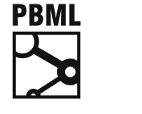


The Prague Bulletin of Mathematical Linguistics
Enhancing Derivational Information on Latin Lemmas in the LiLa Knowledge Base. A Structural and Diachronic Extension
Matteo Pellegrini, Marco Passarotti, Eleonora Litta, Francesco Mambrini, Giovanni Moretti, Claudia Corbetta, Martina Verdelli
References:
- Mark Aronoff. Morphology by Itself: Stems and Inflectional Classes, MIT Press, Cambridge, MA, 1994.
- Geert Booij and Ans van Kemenade. Preverbs: an introduction In Yearbook of morphology 2003, pages 1–11, Kluwer, Dordrecht, 2003. (http://doi.org/10.1007/978-1-4020-1513-7_1)
- Geert Booij. Construction morphology Language and linguistics compass 4, pages 543–555, Wiley Online Library, 2010. (http://doi.org/10.1017/9781139814720.016)
- Paul Buitelaar, Philipp Cimiano, John McCrae, Elena Montiel-Ponsoda, and Thierry Declerck. Ontology Lexicalization: The lemon Perspective In Proceedings of the Workshops-9th International Conference on Terminology and Artificial Intelligence (TIA 2011), pages 33–36, 2011.
- Christian Chiarcos, Katerina Gkirtzou, Fahad Khan, Penny Labropoulou, Marco Passarotti, and Matteo Pellegrini. Computational Morphology with OntoLex-Morph In 8th Workshop on Linked Data in Linguistics, pages 78–86, 2022.
- Christian Chiarcos and Maria Sukhareva. OLiA – Ontologies of Linguistic Annotation Semantic Web 6, pages 379–386, 2015. (http://doi.org/10.3233/SW-140167)
- Philipp Cimiano, Christian Chiarcos, John McCrae, and Jorge Gracia. Linguistic Linked Data, Springer, 2020. (http://doi.org/10.1007/978-3-030-30225-2)
- Charles du Fresne sieur du Cange, bénédictins de la congrégation de Saint-Maur, d. Pierre Carpentier, Johann Christoph Adelung, G. A. Louis Henschel, Lorenz Diefenbach, and Léopold Favre. Glossarium mediae et infimae latinitatis, Favre, Niort, France, 1883–1887.
- Egidio Forcellini. Lexicon totius latinitatis, Arnaldo Forni, Bologna, Italy, 1965.
- Karl Ernst Georges. Ausführliches lateinisch-deutsches Handwörterbuch, Wissenschaftliche Buchgesellschaft, Darmstadt, Germany, Reprint of first edition of 1913–1918, Hannover, Germany: Hahnsche Buchhandlung., 1998.
- Hercule Géraud. Historique du Glossaire de la basse latinité de Du Cange Bibliothèque de l’École des chartes, pages 498–510, JSTOR, 1839. (http://doi.org/10.3406/bec.1840.461649)
- Otto Gradenwitz. Laterculi vocum Latinarum: voces Latinas et a fronte et a tergo ordinandas, Hirzel, Leipzig, 1904.
- Sebastian Hellmann, Jens Lehmann, Sören Auer, and Martin Brümmer. Integrating NLP using Linked Data In Proc. 12th International Semantic Web Conference, 21-25 October 2013, Sydney, Australia, 2013. (http://doi.org/10.1007/978-3-642-41338-4_7)
- Bettina Klimek, John McCrae, Julia Bosque-Gil, Maxim Ionov, James K. Tauber, and Christian Chiarcos. Challenges for the Representation of Morphology in Ontology Lexicons In Proceedings of eLex, pages 570–591, 2019.
- Lukáš Kyjánek. Harmonisation of Language Resources for Word-Formation of Multiple Languages, 2020.
- Lukáš Kyjánek, Olga Lyashevskaya, Anna Nedoluzhko, Daniil Vodolazsky, and Zdeněk Žabokrtsk. Constructing a Lexical Resource of Russian Derivational Morphology In Proceedings of the 13th Conference on Language Resources and Evaluation (LREC 2022), pages 2788–2797, 2022.
- Mateusz Lango, Zdeněk Žabokrtsk and Magda Ševčíková. Semi-automatic construction of word-formation networks Language Resources and Evaluation 55, pages 3–32, Springer, 2021. (http://doi.org/10.1007/s10579-019-09484-2)
- Ora Lassila and Ralph R. Swick. Resource Description Framework (RDF) Model and Syntax Specification, 1998.
- Christian Chiarcos and Christian Fäth. CoNLL-RDF: Linked Corpora Done in an NLP-Friendly Way In Language, Data, and Knowledge, pages 74–88, Springer, Cham, Switzerland, 2017. (http://doi.org/10.1007/978-3-319-59888-8_6)
- Christian Lehmann. Latin preverbs and cases In Latin linguistics and linguistic theory: Proceedings of the 1st International Colloquium on Latin Linguistics, pages 145–161, John Benjamins, Amsterdam, 1983. (http://doi.org/10.1075/slcs.12.15leh)
- Eleonora Litta, Marco Passarotti, and Francesco Mambrini. Derivations and Connections: Word Formation in the LiLa Knowledge Base of Linguistic Resources for Latin The Prague Bulletin of Mathematical Linguistics, pages 163–186, 2020. (http://doi.org/10.14712/00326585.010)
- Eleonora Litta and Marco Budassi. What we talk about when we talk about paradigms: representing Latin word formation In Paradigmatic relations in word formation, pages 128–163, Brill, 2020.
- Eleonora Litta and Marco Passarotti. (When) inflection needs derivation: a word formation lexicon for Latin In Lemmata Linguistica Latina. Volume 1. Words and Sounds, pages 224–239, De Gruyter, Berlin, Boston, 2019. (http://doi.org/10.1515/9783110647587-015)
- John McCrae, Julia Bosque-Gil, Jorge Gracia, Paul Buitelaar, and Philipp Cimiano. The OntoLex-Lemon Model: Development and Applications In Proceedings of eLex, pages 587–597, 2017.
- Peter G. W. Glare. Oxford Latin Dictionary, Oxford University Press, Oxford, uk, 2012.
- Marco Passarotti, Marco Budassi, Eleonora Litta, and Paolo Ruffolo. The Lemlat 3.0 Package for Morphological Analysis of Latin In Proceedings of the NoDaLiDa 2017 Workshop on Processing Historical Language, pages 24–31, 2017.
- Marco Passarotti, Francesco Mambrini, Greta Franzini, Flavio Massimiliano Cecchini, Eleonora Litta, Giovanni Moretti, Paolo Ruffolo, and Rachele Sprugnoli. Interlinking through Lemmas. The Lexical Collection of the LiLa Knowledge Base of Linguistic Resources for Latin Studi e Saggi Linguistici lviii, pages 177–212, 2020.
- Emil Svoboda and Magda Ševčíková. Word Formation Analyzer for Czech: Automatic Parent Retrieval and Classification of Word Formation Processes The Prague Bulletin of Mathematical Linguistics, pages 55–73, 2022. (http://doi.org/10.14712/00326585.019)